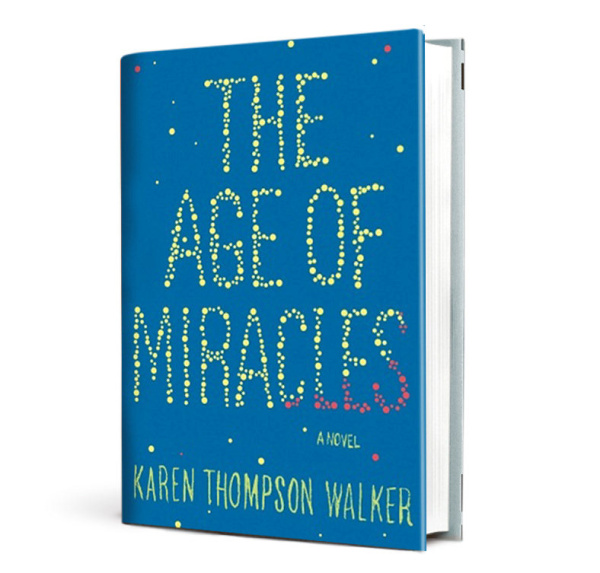

The world as we know it is ending. Earth’s rotations have slowed, and the disastrous implications of what society refers to as “the slowing” begin to become clear. Days grow longer first by minutes, then hours, then days and weeks. The government urges people to adhere to “clock time,” now based only on tradition instead of sunlight. Subtle shifts in gravity and circadian rhythms alter peoples’ health as changes in the atmosphere and weather bring natural disasters and crop crises. This is the premise of Karen Thompson Walker’s “The Age of Miracles.”
The recent novel is Walker’s first, but it caused a stir in the publishing industry even before going to print — according to the New York Times, publishers enthusiastic about the book’s potential offered Walker an unprecedented seven-figure deal. Apocalyptic narratives are nothing new — it’s hard to sit through movie previews today without seeing at least one familiar landmark succumb to slow-motion CGI destruction — but “The Age of Miracles” offers a fresh take on the premise. The story’s narrator is an eleven-year-old Californian, Julia, whose personal world is changing as quickly and dramatically as her planet. Watching sunsets at two in the morning evokes the same apprehension as seeing strains emerge in her parents’ marriage. The middle-school world of unreliable friendships and overwhelming crushes doesn’t stop as “the slowing” gradually escalates. Julia’s perspective brings the story further from science fiction and closer to the metaphor-heavy category of magical realism. By superimposing two familiar narratives —end-of-the-world and coming-of-age — “The Age of Miracles” creates something entirely new.
Some critics of the book have argued that a planetary crisis does not make an easy backdrop and “the slowing” should be more of the plot than merely a plot device. In the novel, not much is made of the fact that the change’s cause remains undiscovered, and the truly global effects of the catastrophe are not dealt with in depth. These choices do occasionally detract from the gravitas and credibility of “the slowing.”
However, the way that “the slowing” serves as a frame for Julia’s story is the most intriguing part of the novel. Instead of just recounting a disaster, the book traces the way extreme situations draw out different reactions from people: suffusing relationships with tension and rearranging the urgency of everyday life. Julia’s mother grows paranoid, stockpiling food, while her father grows detached. When Julia’s best friend moves away after her family’s religion forecasts the apocalypse, the two girls start to grow apart — a recognizable fate of childhood friendships triggered by the new disaster. Julia gets closer to her crush as they experience the new phenomena together and explore the sunlit nights. The dramatic changes in the world — dying plants and animals, dangerous solar radiation, power and communication blackouts — are not only interesting, but also just realistic enough to avoid becoming distractions. They echo and underscore what Julia begins to believe as she grows up: it is impossible to recapture the innocence of the past and the world is untrustworthy.
“The Age of Miracles” is not an optimistic title — it refers to puberty, “the time when kids shot up three inches over the summer, when voices dipped and dove,” and change — not so much miraculous change as change on a miraculously large scale. “What had been familiar once became less and less so….as strange as the new days seemed to us at first, the old days would come to feel very quickly the stranger.”
Walker, who spent three years writing the book in the mornings before her job at a publishing house, writes with sparse, lyrical sentences. Although the story follows the year before she turned 12, Julia is narrating the novel as a young adult. Even her less melancholy, more nostalgic moments (which are few) are tinged with foreshadowing of the final tragic results of “the slowing,” and the tone is kept somber: if the story ever starts to feel quotidian, it is derailed by remarks like “it was the last time I ever tasted a grape.” Nonetheless, the grave mood of the book does not detract from its readability. Julia is a very sympathetic character. Even in the speculative setting, her coming-of-age concerns are universally relatable.
While more literary than some apocalyptic stories, “the slowing” is still engaging to follow. The frenzied bidding surrounding its publication is easy to understand: “The Age of Miracles” is an intrinsically high-quality book. It has even more to offer, however, because of the resonance of its central disaster.
Fortunately, Walker is restrained in explicitly drawing the parallels to climate change that “the slowing” seems to demand. Instead, such connections are left to the reader, and they are almost too easy. The juxtaposition of Julia’s adolescence and the world’s decline will be very familiar to readers from a post-9/11 generation that came of age watching society react to transformational crises that were only slightly less fantastical. The difficulty of change and the instability of the world are classic topics, but they are made fascinating again by “The Age of Miracle”’s creative premise.